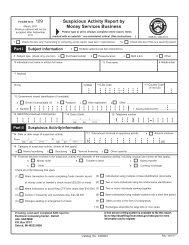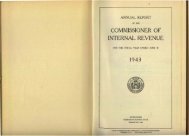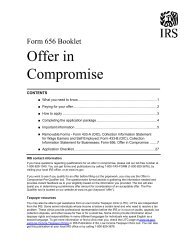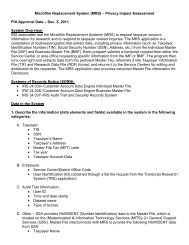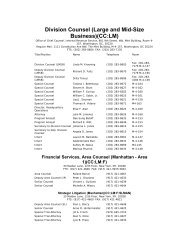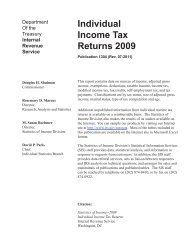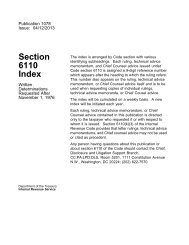Exempt Organization Business Income Tax Returns, 1991organizations showing UBI tax on <strong>the</strong>ir returns was13,908, or 476 less than might o<strong>the</strong>rwise be expected.The explanation for this is that <strong>the</strong>re were 524 organizationswhich had positive amounts <strong>of</strong> taxable income butreported no UBI tax, and <strong>the</strong>re were 49 organizations thatreported UBI tax even though <strong>the</strong>y had no taxable income(13,908 plus 524 minus 49 equals 14,383) [10].The tax statistics cited above are based. on-originall'yfiled returns that were selected prior to IRS audit examinationand prior to <strong>the</strong> filing <strong>of</strong> any amended returns. Recomputation<strong>of</strong> <strong>the</strong> tax resuiting from taxpayer errorsdetected after filing, ei<strong>the</strong>r by i <strong>the</strong> filing organization orthrough IRS data checks, has not been taken into account.Therefore, <strong>the</strong> amount <strong>of</strong> tax actually assessed and collectedmay be different from <strong>the</strong> amount initially reportedand presented in this article.Of <strong>the</strong> 32,690 exempt organizations which filed Forms990-T, 27,539 exempt corporations accounted for 92percent <strong>of</strong> <strong>the</strong> $3.4 billion <strong>of</strong> total gross LJBI while 5,151-exempt-trusts-accounted-for <strong>the</strong>-remainder. There-were-11,348 exempt corporations and 2,560 exempt trusts thatreported <strong>the</strong> UBI tax on <strong>the</strong>ir returns for 1991, comparedto 11,378 corporations and 2,527 trusts that reported totaltax. Corporations were liable for $70.2 million, 60 per~cent, <strong>of</strong> LJBI tax, and trusts werr liable for $46.4 million,40 percent. Corporate and trust total tax liabilityamounted to $70.5 million and $46.4 million, respectively.Of all Form 990-T filers for 1991, section 501(c)(3)organizations were responsible for <strong>the</strong> largest share (35percent) <strong>of</strong> total tax reported, $40.6 million. Toge<strong>the</strong>r,organizations exempt under sections 501(c)(3), (4), (6),(7), and (9) accounted for 88 percent <strong>of</strong> total tax reported.Figure F shows a percentage distribution <strong>of</strong><strong>the</strong> respectiveshares <strong>of</strong> gross UBI, total deductions, positive UBTI, andtotal tax attributable to <strong>the</strong>se five types <strong>of</strong> organizations.Collectively, <strong>the</strong>se organizations filed 69 percent <strong>of</strong> <strong>the</strong>Forms 990-T, and accounted for between 86 and 88percent <strong>of</strong> <strong>the</strong> totals reported by all organizations for <strong>the</strong>key items shown in Figure F.Voluntary employees' beneficiary associations describedin section 501(c)(9) were responsible for 31-percent-<strong>of</strong> total-tax-reportedl-a-high-percentage-given-<strong>the</strong>factthat <strong>the</strong>y accounted for only 2 percent <strong>of</strong> all filers and6 percent <strong>of</strong> total gross UBI. In addition, <strong>the</strong> share <strong>of</strong> totalFigure FSelected Financial Data Reported by Principal Types <strong>of</strong> Organizations as a Percentage <strong>of</strong> <strong>the</strong> TotalReported by All Types <strong>of</strong> Organizations, Tax Year 1991Total gross unrelatedbusiness income($3A billion)Total positive unrelatedbusiness taxable Income($OA billion)Total deductions($4.0 billion)Total Income tax($0.1 billion)501(cX3)501(cX4) 501(cXG) , ,501(CX7)501(CX9)Types shown, totalType <strong>of</strong> Organization, by <strong>Internal</strong> <strong>Revenue</strong> Code SectionExcludes cost <strong>of</strong> sales and serAces, which was not included on <strong>the</strong> return as a component <strong>of</strong> total deductions. it was subtracted from gross receipts in computinggross pr<strong>of</strong>it from safes and services, reported as a gross income component. Cost <strong>of</strong> sales and serAces can include amounts attributable to depreciation, salariesand wages, and o<strong>the</strong>r deductible items.NOTE: Detail may not add to totals because <strong>of</strong> rounding.
Exempt Organization Business Income Tax Returns, 1991positive UBTI attributable to section 501(c)(9) organizationswas 27 percent, but <strong>the</strong>se organizations accountedfor only 2 percent <strong>of</strong> organizations that reported positiveUBTL Voluntary employees' beneficiary associationsgenerally were not able to take deductions as large as mosto<strong>the</strong>r types <strong>of</strong> organizations because <strong>of</strong> <strong>the</strong> nature <strong>of</strong> <strong>the</strong>irexempt activities, discussed below.Section 501(c)(9) organizations primarily engage ininvestment activities in order to fund <strong>the</strong> benefits paid outto member-employees. Nearly 75 percent <strong>of</strong> <strong>the</strong>ir aggregategross UBI was reported as investment income for1991. As mentioned in <strong>the</strong> discussion <strong>of</strong> deductions, <strong>the</strong>largest deduction item, by far, reported by employees'beneficiary associations was for amounts set aside toprovide for future payment <strong>of</strong> life, sick, accident, or o<strong>the</strong>rbenefits. However, if amounts were set aside that exceeded<strong>the</strong> qualified asset account limits, as specified insection 419A <strong>of</strong> <strong>the</strong> Code, <strong>the</strong>n <strong>the</strong>y were not allowed as adeduction from unrelated business investment income. Ino<strong>the</strong>r words, if a section 501 (c)(9) association overfundedan employee welfare benefit plan, its investment incomecould not be set aside tax-free. It was taxable as unrelatedbusiness income.Ano<strong>the</strong>r factor contributing to <strong>the</strong> relatively smalldeductions taken by <strong>the</strong> employee beneficiary associationsis that, for many <strong>of</strong> <strong>the</strong>m, <strong>the</strong>ir investment portfoliostypically are overseen by a single trust manager. Because<strong>the</strong>re is no need for a staff <strong>of</strong> employees, deductions forsalaries and wages are quite small. In terms <strong>of</strong> contrast,salaries and wages reported by section 501 (c)(9) associationswere less than half a percent <strong>of</strong> total salaries andwages reported by all organizations, compared to 61percent for <strong>the</strong> section 501(c)(3) organizations. As apercentage <strong>of</strong> <strong>the</strong> total deductions reported by <strong>the</strong>se twotypes <strong>of</strong> organizations, salaries and wages comprised a 2-percent share for <strong>the</strong> section 501(c)(9) organizationscompared to an 18-percent share for section 501(c)(3)organizations [11].Primary Unrelated Business Activity by IndustrialGroupingOrganizations filing a Form 990-T for 1991 were requiredto enter at least one, and up to three, industry codes for<strong>the</strong>ir principal business activities, based on <strong>the</strong> amount <strong>of</strong>gross unrelated business income <strong>the</strong>y generated. If anorganization engaged in more than one type <strong>of</strong> activity, itwas instructed to list <strong>the</strong> code for <strong>the</strong> largest unrelatedactivity (in terms <strong>of</strong> gross income) first, <strong>the</strong>n <strong>the</strong> codes for<strong>the</strong> next two largest activities, in descending order. Thediscussion <strong>of</strong> unrelated business activities that followstakes into consideration only <strong>the</strong> primary (first) activity<strong>Service</strong>s and finance, code reported. Because it isnot possible to distribute grossinsurance, and realUBI by each type <strong>of</strong> activityestate accounted for when more than one activity78 percent <strong>of</strong> grosswas reported, <strong>the</strong> amount <strong>of</strong>gross UBI assigned to <strong>the</strong>unrelated business primary unrelated businessincome.activity may not be entirelyrelated to that activity.Figure G shows that <strong>the</strong> primary unrelated businessactivity reported on 88 percent <strong>of</strong> returns filed fell withinfour major industrial groupings: manufacturing; retailtrade; services; and finance, insurance, and real estate (seeTable 5 for information on <strong>the</strong> major business activities orindustrial classifications reported). These four industrialgroupings were also responsible for 93 percent <strong>of</strong> totalgross UBI, with manufacturing producing $0.1 billion;retail trade, $0.4 billion; services, $1.5 billion; and finance,insurance, and real estate, $1.1 billion.The industrial classifications from which Form 990-Tfilers were required to make a choice included 155 industrycodes and 5 additional categories that were establishedspecifically for exempt organizations engaging in unrelatedbusiness activities to reflect particular provisions <strong>of</strong> <strong>the</strong><strong>Internal</strong> <strong>Revenue</strong> Code [12]. These five classificationswere unrelated debt-financed activities o<strong>the</strong>r than rental <strong>of</strong>real estate; investment activities <strong>of</strong> section 501(c)(7), (9),(17), and (20) organizations; rental <strong>of</strong> personal property;passive income activities with controlled organizations;and exploited exempt activities. In Figure G and Table 5,<strong>the</strong> first four activities mentioned above are treated as part<strong>of</strong> <strong>the</strong> finance, insurance, and real estate division. Exploitedexempt activities is treated separately in Figure Gand Table 5 as one <strong>of</strong> <strong>the</strong> major industrial groupings [13].There were 1,495 organizations that reported unrelatedactivities in <strong>the</strong> manufacturing division. Most <strong>of</strong> <strong>the</strong>m, 87percent, could be categorized under two types <strong>of</strong> unrelatedactivities: printing and publishing, 45 percent, and petroleumrefining and related industries, 42 percent [14].Three percent <strong>of</strong> total gross UBI was attributable to <strong>the</strong>printing and publishing industrial sub-group. Petroleumrefining and related industries accounted for only one-tenth<strong>of</strong> I percent <strong>of</strong> total gross UBI. Business leagues, realestate boards, and various types <strong>of</strong> nonpr<strong>of</strong>it charitableorganizations accounted for. most <strong>of</strong> <strong>the</strong> printing andpublishing carried on by tax-exempt organizations as <strong>the</strong>irprincipal unrelated trade or business activity. Almost all <strong>of</strong><strong>the</strong> organizations that reported petroleum refining andrelated industries as <strong>the</strong>ir principal unrelated businessactivity were trusts that acted as fiduciary agents for IndividualRetirement Arrangements and pr<strong>of</strong>it-sharing plans.45
- Page 1 and 2: SPRING 1995. o .............. o..o.
- Page 3 and 4: SOI BULLETINA Quarterly Statistics
- Page 5 and 6: Bulletin Board1986, the annual grow
- Page 7 and 8: Bulletin Boardmelectronic bulletin
- Page 9 and 10: Revisions to the Fall 1994 Issue0at
- Page 11 and 12: Individual Income Tax Returns, Prel
- Page 13 and 14: Individual Income Tax Returns, Prel
- Page 15 and 16: Individual Income Tax Returns, Prel
- Page 17 and 18: Individual Income Tax Returns, Prel
- Page 19 and 20: Individual Income Tax Returns, Prel
- Page 21 and 22: Individual Income Tax Returns, Prel
- Page 23 and 24: Individual Income Tax Returns, Prel
- Page 25 and 26: Individual Income Tax Returns, Prel
- Page 27 and 28: Individual Income Tax Returns, Prel
- Page 29 and 30: Individual Income Tax Returns, Prel
- Page 31 and 32: Foreign Recipients of U.S. Income,
- Page 33 and 34: Foreign Recipients of U.S. Income,
- Page 35 and 36: Foreign Recipients of U.S. Income,
- Page 37 and 38: Foreign Recipients of U.S. Income,
- Page 39 and 40: Foreign Recipients of U.S. Income,
- Page 41 and 42: Exempt Organization Business Income
- Page 44 and 45: Exempt Organization Business Income
- Page 48 and 49: Exempt Organization Business Income
- Page 50 and 51: Exempt Organization Business Income
- Page 52 and 53: Exempt Organization Business Income
- Page 54 and 55: Exempt Organization Business Income
- Page 56 and 57: Exempt Organization Business Income
- Page 58 and 59: Exempt Organizati6-n Business Incom
- Page 60 and 61: Exempt Organizaition Business Incom
- Page 62 and 63: Exempt Organization Business Income
- Page 64 and 65: Exempt Organization Business Income
- Page 66 and 67: NOWHer-Proffles, Fiscal Year 1993.b
- Page 68 and 69: Nonfiler Profiles, Fiscal Year 1993
- Page 70 and 71: Nonfiler Profiles, Fiscal Year 1993
- Page 72 and 73: Nonfiler Profiles, Fiscal Year 1993
- Page 74 and 75: Nonfiler Profiles, Fiscal Year 1993
- Page 76 and 77: S Corporation Returns, 1992Figure A
- Page 78 and 79: .S Corporation Returns, 1992trillio
- Page 80 and 81: S Cor*.:'- ,pg_&~A' IQn Retilms,, 1
- Page 82 and 83: S Corporation Returns, 1992Figure I
- Page 84 and 85: S Corporation Returns, 1992Table I.
- Page 86 and 87: S Corporation Returns, 1992Table 1.
- Page 88 and 89: S Corporation Returns, 1992Table 1-
- Page 90 and 91: S Corporation Returns, 1992Table I.
- Page 92 and 93: S Corporation Returns, 1992Table 1.
- Page 94 and 95: S Corporation Returns, 1992Table 2.
- Page 96 and 97:
-2,956,349S Corporation Returns, 19
- Page 98 and 99:
S Corporation Returns, 1,992Table 2
- Page 100 and 101:
S Corporation Returns, 1992Table 2.
- Page 102 and 103:
S Corporation Returns, 1992Table 3.
- Page 104 and 105:
Estate Tax Retums, 1992-1993'102was
- Page 106 and 107:
Estate Tax Retums, 1992-1993Table 1
- Page 108 and 109:
Estate' Tax Retums, 1992-1993Table
- Page 110 and 111:
Estate Tax Retums, 1992-199.3Table
- Page 112 and 113:
Estate Tax Retums, 199271993Table 2
- Page 114 and 115:
Estate Tax Retums, 1992-1993Table 2
- Page 116 and 117:
Estate Tax Retums, 1992-1993Table 3
- Page 118 and 119:
Selected Historical and Other DataT
- Page 120 and 121:
Selected Historical and Other DataT
- Page 122 and 123:
Selected Historical and Other DataT
- Page 124 and 125:
Selected Historical and Other DataT
- Page 126 and 127:
Selected Historical and Other DataT
- Page 128 and 129:
Selected Historical and Other DataT
- Page 130 and 131:
Selected Historical and Other DataT
- Page 132 and 133:
Selected Historical and Other DataT
- Page 134 and 135:
Selected Historical and Other DataT
- Page 136 and 137:
Selected Historical and Other DataT
- Page 138 and 139:
Selected Historical and Other DataT
- Page 140 and 141:
Selected Historical and Other DataT
- Page 142 and 143:
Selected Historical and Other DataT
- Page 144 and 145:
Selected Historical and Other DataT
- Page 146 and 147:
Selected Historical and Other DataT
- Page 148 and 149:
Selected Historical and Other DataT
- Page 150 and 151:
Selected Historical and Other DataT
- Page 152 and 153:
Selected Historical and Other DataT
- Page 154 and 155:
Selected Historical and Other DataT
- Page 156 and 157:
Selected Historical and Other DataT
- Page 158 and 159:
Selected Historical and Other DataT
- Page 160 and 161:
Selected Historical and Other DataT
- Page 162 and 163:
Selected Historical and Other DataT
- Page 164 and 165:
Selected Historical and Other DataT
- Page 166 and 167:
Selected Historical and Other DataT
- Page 168 and 169:
Selected Historical and Other DataT
- Page 170 and 171:
Selected Historical and Other DataT
- Page 172 and 173:
Selected Historical and Other DataT
- Page 174 and 175:
Selected Historical and Other DataT
- Page 176 and 177:
Selected Historical and Other DataT
- Page 178 and 179:
Selected Historical and Other DataT
- Page 180 and 181:
10It- - - - - - - - - - - - - - - -
- Page 182 and 183:
Selected Historical and Other DataT
- Page 184 and 185:
Selected Historical and Other DataT
- Page 186 and 187:
Selected Historical and Other DataT
- Page 188 and 189:
Selected Historical and Other DataT
- Page 190 and 191:
Selected Historical and Other DataT
- Page 192 and 193:
Selected Historical and Other DataT
- Page 194 and 195:
Selected Historical and Other DataT
- Page 196 and 197:
Notes to Selected Historical and Ot
- Page 198 and 199:
Notes to Selected Historical and Ot
- Page 200 and 201:
Notes to Selected Historical and Ot
- Page 202 and 203:
Notes to Selected Historical and Ot
- Page 204 and 205:
Notes to Selected Historical and Ot
- Page 206 and 207:
Notes to Selected Historical and Ot
- Page 208 and 209:
iAnnouncing,New IRSMethodoloffRepor
- Page 210 and 211:
Publications, & Tapesment, balance
- Page 212 and 213:
'SO1 Projects and ContactsGeneral S
- Page 214 and 215:
SOI Proj6cts and ContactsGeneral St
- Page 216 and 217:
S01 Sampling Methodology and Data L
- Page 218 and 219:
S01 Sampling Methodology and DataLi
- Page 220:
IIIIDepirtment of the TreasuryInter



![l..l.l.L. 4DB.DI3-l]t] xxxxxxxxxxxxxxxx - Internal Revenue Service](https://img.yumpu.com/51302394/1/190x245/llll-4dbdi3-lt-xxxxxxxxxxxxxxxx-internal-revenue-service.jpg?quality=85)

